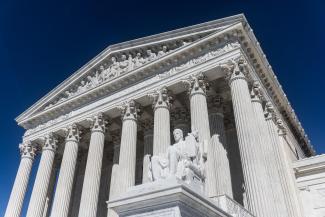The Clean Water Act does not cover groundwater. But what if an aquifer acts as a “conduit” to surface water? Is a facility liable if pollutants discharged into groundwater eventually flow into “waters of the United States,” which are covered under the act? Must facilities obtain permits in such circumstances?
The answer to these questions has been about as clear as mud. Practitioners are watching to see if the Supreme Court will take up the issue this term, to resolve a brewing circuit split, and if EPA and the Justice Department will finally clarify where the government stands.
The courts have been all over the map. For example, a recent Ninth Circuit case, County of Maui v. Hawaii Wildlife Fund, involved a locality-operated wastewater facility that used underground injection wells to dispose of treated sewage, where pollutants from the well seeped into the Pacific Ocean through groundwater. The court held that a National Pollutant Discharge Elimination System permit was required because the pollutants originated “from a point source” and “are fairly traceable from the point source to a navigable water.”
The Fourth Circuit followed suit in Kinder Morgan Energy Partners LP v. Upstate Forever, where a pipeline in South Carolina ruptured, leaking gasoline into groundwater, which later contaminated local streams. The court held that the “direct hydrological connection between groundwater and navigable waters” meant the discharge was regulated by the CWA.
The Sixth Circuit has taken the opposite tack in a pair of recent cases, including Kentucky Waterways Alliance v. Kentucky Utilities Co., which rejected a CWA citizen suit based on chemicals stored in a coal ash pond that allegedly traveled through groundwater to a nearby lake. Expressly disagreeing with its sister circuits, the appeals court ruled that the definition of “discharge” requires that a point source deliver pollutants directly to navigable waters.
Meanwhile, the government has sent mixed signals. In 2016, DOJ filed an amicus brief in the County of Maui case, supporting the district court’s finding of liability, albeit on a narrower theory. “It has been EPA’s longstanding position that discharges moving through groundwater to a jurisdictional surface water are subject to CWA permitting requirements,” but only “if there is a ‘direct hydrological connection’ between the groundwater and the surface water,” Justice lawyers told the court. The department advocated a case-by-case inquiry, recognizing that “some hydrological connections are too circuitous and attenuated to come under the CWA.”
The amicus brief would have required authorization from the solicitor general — entailing a rigorous review process — which meant the government’s position was now pretty well defined, right? Not so fast.
In February 2018, EPA published a notice soliciting input on whether it should continue to adhere to these views, in particular, on whether and to what extent “subjecting such releases to CWA permitting is consistent with the text, structure, and purpose of the CWA.” The agency said it would clarify its views through “memoranda, guidance, or in the form of rulemaking” to “provide additional certainty for the public and the regulated community.” But EPA has yet to act.
Fast forward to December. In response to petitions for certiorari filed in the Ninth and Fourth circuit cases, the Supreme Court issued a formal request for the views of the solicitor general, and, in an unusual move, ordered a response under a tight deadline, putting the government’s feet to the fire.
The United States submitted an amicus brief urging the Court to grant certiorari to decide “whether a ‘discharge of a pollutant,’ . . . occurs when a pollutant is released from a point source, travels through groundwater, and ultimately migrates to navigable waters.” Notably, however, the SG, keeping his cards close to the vest, was silent as to how EPA itself would answer that question. Rather, he reported that the agency would issue clarification “within the next several weeks.” The SG nonetheless declared a strong interest in resolving the matter, which “has the potential to affect federal, state, and tribal regulatory efforts in innumerable circumstances nationwide.”
Practitioners seeking to advise their clients are watching these developments closely. Will the Supreme Court agree to hear the case? Will EPA articulate its views, either through guidance or rulemaking, and if so, will it adhere to its Ninth Circuit arguments, flip positions, or land somewhere in between? And wherever the agency lands, will DOJ continue to argue that EPA’s interpretation is entitled to Chevron deference? Meanwhile, if the Supreme Court grants the case, practitioners will be looking for clues as to what kind of interpretive approach the justices might take if and when they have the chance to review the agency’s ongoing rule redefining “waters of the United States.”



